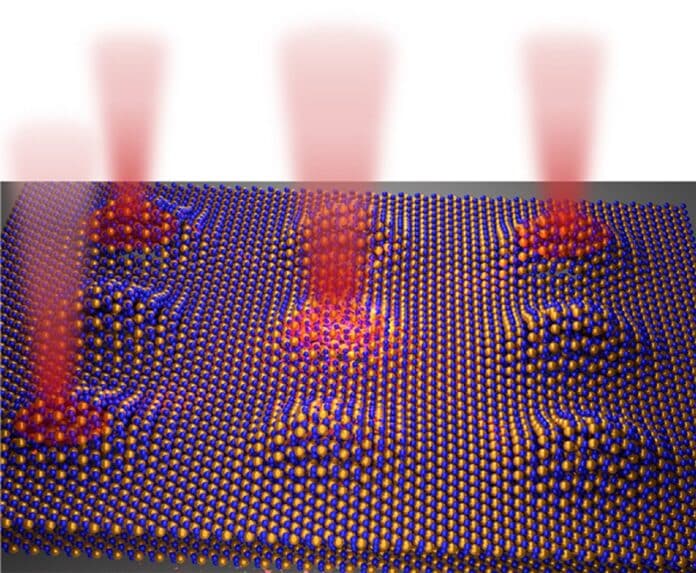A team led by UW ECE and Physics Professor Mo Li discovered a technique to use the “breathing” between two layers of atoms, creating a new building block for quantum technologies.
Breathing is a primordial act. In a certain sense, plants, animals, humans, and even non-living objects like the Earth and the oceans exhibit various forms of respiration. Natural systems of all sizes that breathe or behave in a way that is very similar to breathing may be found all over the world.
Therefore, it should come as no surprise that this kind of “breathing” phenomenon also occurs at the atomic level in light of the previous.
The mechanical vibration between two layers of atoms, known as atomic “breathing,” may now be detected by a research team from the University of Washington by observing the light those atoms generate when triggered by a laser.
They will now be able to encode and send quantum information using the sound of this atomic ‘breath.’ A gadget they constructed could act as a novel quantum technology building block.
As a result, the team’s invention may act as a novel building block for quantum technologies, which are expected to have a wide range of future applications in industries including computers, communications, and sensor development.
The study uses a concept known as “optomechanics,” which describes the intrinsic coupling of mechanical and optical motions, to give scientists and engineers a new tool for creating quantum computer circuitry.
Li said. “It provides a new type of involved quantum effect that can be utilized to control single photons running through integrated optical circuits for many applications.”
This study developed from earlier research by the Mo Li Group on a quantum-level quasiparticle known as an “exciton.” Because information can be encoded into an exciton and subsequently released from it as photons, a minute energy particle regarded as the quantum unit of light, this quasiparticle is crucial.
Each photon’s quantum characteristics can serve as a “qubit,” or quantum bit, of information for quantum computing and communication.
Adina Ripin, a lead author of the paper, a member of the Mo Li Group, and a doctoral student in the physics department, said, “The bird’s-eye view of this research is that to have a quantum network feasibly, we need to have ways of reliably creating, operating on, storing and transmitting qubits, Photons are a natural choice for transmitting this quantum information because optical fibers enable us to transport photons long distances at high speeds, with low losses of energy or information.”
A key element of quantum technologies based on light and optics is the single photon emitter, or “quantum emitter,” developed by the research team using excitons.
The scientists did this by putting two layers of tungsten diselenide, a material made of tungsten and selenium atoms, one on the other. In reality, these layers are considered two-dimensional because they are so thin—each is only one atom thick.
Ripin explained, “Two-dimensional quantum materials such as this are really interesting systems for storing quantum information because the reduced dimensionality of the material leads to many unique quantum states that are extremely stable.”
The two layers of tungsten diselenide were pressed onto a substrate lined with thousands of small pillars that were barely 200 nanometers across each.
The atomic layers covered these nanopillars, which caused very little tension in the substance. Each nanopillar’s location under tension resulted in the creation of a “strain-induced quantum dot.
The team placed the quantum emitter on the substrate by creating a strain-induced quantum dot that isolated excitons inside a constrained area.
The group created an exciton quasiparticle by using a laser pulse to precisely knock an electron away from the nucleus of a tungsten diselenide atom. The electron briefly paused before returning to the hole.
The researchers found that the tungsten diselenide atoms also created a quasiparticle called a phonon in addition to photons and excitons. Atomic vibration is a natural phenomenon occurring in all matter, giving rise to phonons. This was the first time phonons had ever been seen in a single photon emitter in such a two-dimensional atomic system.
The team’s measurements and analysis of the emitted light’s spectrum revealed many intriguing, evenly-spaced peaks.
According to Ting Cao, an assistant materials science and engineering professor, and a quantum theorist, Every photon released by an exciton was quickly found to be associated with one, two, three, or more phonons.
A phonon is a natural quantum vibration of the tungsten diselenide material that strongly influences the optical characteristics of the exciton’s photon.
Li explained. “This has a powerful effect on the optical properties of the photon emitted by the exciton that has never been reported before.”
Their discovery inspired the team to develop concepts for using phonons in quantum technologies. They discovered that by varying the electrical voltage, they could change the interaction energy of the related phonons and release photons.
This fluctuation was observable and controllable in ways important to quantum information encoding into a single photon emission. Ruoming Peng, the paper’s primary author, is currently a postdoctoral researcher at the University of Stuttgart in Germany, where he wants to continue his study on quantum systems.
To regulate many quantum emitters and their associated phonon states, the research team is developing a waveguide — fibers on a chip that catch single photon emissions and steer them where they need to go.
This will allow the quantum emitters to “talk” to one another, laying the groundwork for quantum circuits. The idea is to construct an integrated system with quantum emitters for quantum computing and sensing using single photons passing via optical circuits and the newly discovered phonons.
The national science foundation funded the study.
Journal Reference:
- Ripin, A., Peng, R., Zhang, X., Chakravarthi, et al. Tunable phononic coupling in excitonic quantum emitters. Nature Nanotechnology. DOI: 10.1038/s41565-023-01410-6
